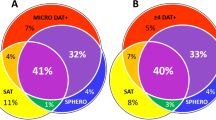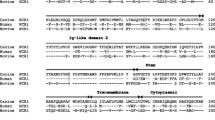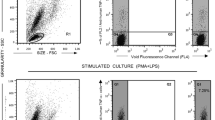Abstract
Clinical applications of flow cytometry to certain diseases of the dog and cat are now possible. The utility of such applications for diagnosis, prognosis and follow-up are illustrated here by a number of examples: feline AIDS resulting from FIV infection, Leukocyte Adhesion Deficiency in Irish setters, deep pyoderma in German shepherds, Immune-mediated Thrombocytopenia, canine Systemic Lupus Erythematosus and Leishmaniasis, Leukemia and Lymphoma.
Similar content being viewed by others
References
Appelbaum FR, Sale GE, Storb R, et al. (1984). Phenotyping of canine lymphoma with monoclonal antibodies directed against cell surface antigens: Classification, morphology, clinical presentation, and response to chemotherapy. Hematol Oncol 2: 151-158.
Bendinelli M, Pistello M, Lombardi S, et al. (1995). Feline immunodeficiency virus: an interesting model for A.I.D.S. studies and an important cat pathogen. Clin Microbiol Rev 8: 87-112.
Bergman PJ, Ogilvie GK, Powers BE (1996). Monoclonal antibody C219 immunohistochemistry against P-glycoprotein: Sequential analysis and predictive ability in dogs with lymphoma. J Vet Intern Med 10: 354-359.
Boudreaux MK, Kvam K, Dillon AR, et al. (1996). Type I Glanzmann's thrombasthenia in a Great Pyrenees dog. Vet Pathol 33: 503-511.
Bourdoiseau G, Bonnefont C, Magnol JP, Saint-André I, Chabanne L (1997). Lymphocyte subset abnormalities in canine leishmaniasis. Vet Immunol Immunopathol 56: 345-351.
Bourdoiseau G, Bonnefont C, Hoareau E, et al. (1997). Specific IgG1 and IgG2 antibody and lymphocyte subset levels in naturally Leishmania infantum-infected treated and untreated dogs. Vet Immunol Immunopathol 59: 21-30.
Chabanne L, Marchal T, Kaplanski C, et al. (1994). Screening of 78 monoclonal antibodies directed against human leukocyte antigens for cross-reactivity with surface markers on canine lymphocytes. Tissue Antigens 43: 202-205.
Chabanne L, Fournel C, Caux C, et al. (1995). Abnormalities of lymphocyte subsets in canine systemic lupus erythematosus. Autoimmunity 22: 1-8.
Chabanne L, Marchal T, Denerolle P, et al. (1995). Lymphocyte subset abnormalities in German shepherd dog pyoderma (GSP). Vet Immunol Immunopathol 49: 189-198.
Chabanne L, Fournel C, Monestier M, Monier JC, Rigal D (1999). Canine systemic lupus erythematosus. Part I. Clinical and biologic aspects. Compend Contin Educ Pract Vet 21: 135-141.
Chabanne L, Fournel C, Monier JC, Rigal D (1999). Canine systemic lupus erythematosus. Part II. Diagnosis and treatment. Compend Contin Educ Pract Vet 21: 402-421.
Cobbold SP, Metcalfe S (1994). Monoclonal antibodies that define canine homologues of human CD antigens: Summary of the First International Canine Leukocyte Antigen Workshop (CLAW). Tissue Antigens 43: 186-154.
DeHeer H, Grindem C, Russell K, Cullins L (1999). Flow cytometric analysis of reticulated platelets in dogs: An investigation of platelet kinetics in thrombocytopenic disorders. Abstract from the 1999 Annual Meetings of the ACVP. Vet Clin Path 28: 122.
Denerolle P, Bourdoiseau G, Magnol JP, Ulpat C, Chabanne L (1998). German Shepherd dog pyoderma: A prospective study of 23 cases. Vet Derm 9: 243-248.
Diehl LJ, Hoover EA (1992). Early and progressive helper T-cell dysfunction in feline leukemia virusinduced immunodeficiency. J Acqu Def Synd 5: 1188-1194
English RV, Tompkins MB (1995). Effect of FIV infection on the peripheral immune system. In: Willet BJ, Jarrett O. Feline immunology and immunodeficiency, pp 131-149. Oxford: Oxford University Press.
Felsburg PJ, Hartnett BJ, Henthorn PS, et al. (1999). Canine X-linked severe combined immunodeficiency. Vet Immunol Immunopathol 69: 127-135.
Fournel C, Chabanne L, Caux C, et al. (1992) Canine systemic lupus erythematosus. I. A study of 75 cases. Lupus 1:133-139.
Fournel-Fleury C, Magnol JP, Bricairre P, et al. (1997). Cytohistological and immunological classification of canine malignant lymphomas: Comparison with human non-Hodgkin's lymphomas. J Comp Path 117: 35-59.
Fournel-Fleury C, Magnol JP, Chabanne L, et al. (1997). Growth fractions in canine non-Hodgkin's lymphomas as determined in situ by the expression of the Ki-67 antigen. J Comp Path 117: 61-72.
Frank JR, Breitschwerdt EB (1999). A retrospective study of Ehrlichiosis in 62 dogs from Noth Carolina and Virginia. J Vet Intern Med 13: 194-201.
Fukata T, Ohnishi T, Okuda S, et al. (1996). Detection of canine erythrocytes infected with Babesia gibsoni by flow cytometry. J Parasitol 82: 641-642.
Gardner MB (1991). Simian and feline immunodeficiency viruses: Animal lentivirus models for evaluation of AIDS vaccines and antiviral agents. Antiviral Res 15: 267-286.
Ghernati I, Auger C, Chabanne L, et al. (1999). Characterization of a canine long-term T cell line (DLC 01) established from a dog with Sézary syndrome and producing retroviral particles. Leukemia 13: 1281-1290.
Giger U, Boxer LA, Simpson PJ, Lucchesi BR, Todd III RF (1987). Deficiency of leukocyte surface glycoproteins Mo1, LFA-1 and Leu M5 in a dog with recurrent bacterial infections: An animal model. Blood 69: 1622-1630.
Greenlee PG, Filippa DA, Qimby FW, et al. (1990). Lymphomas in dogs. A morphologic, immunologic and clinical study. Cancer 66: 480-490.
Grindem CB, Page RL, Ammerman BE, Breitschwerdt EB (1998). Immunophenotypic comparison of blood and lymph node from dogs with lymphoma. Vet Clin Path 27: 16-20.
Hannant D (1998). Phagocytosis and flow cytometric analyses: Another step towards an urgent goal. Vet J 156: 79-80.
Kartner N, Evernden-Porelle D, Bradley G, Ling V (1985). Detection of P-glycoprotein in multidrugresistant cell lines by monoclonal antibody. Nature 316: 820-823.
Kijas J, Bauer TR, Gäfvert S, et al. (1999). Canine leukocyte adhesion deficiency is associated with missense mutation in the β-2 integrin gene (ITGB2). Genomics
Kohn B, Engelbrecht R, Giger U, Leibold W (1999). Platelet-bound antibodies detected by a flow cytometric assay in dogs with thrombocytopenia. Proc 9th Annual Congress of the European Society of Internal Medicine: 159 (Vet Int Med, 2000, in press).
Lacombe F, Dumain P, Lopez F, et al. (1989). Flow cytometry and detection of ARA-C resistant leukemic cells. Blood 74 Suppl 1: 233a.
Ladiges WC, Keast M, Appelbaum F, Storb R (1988). Phenotypic characterisation of canine lymphoma using monoclonal antibodies and a microlymphocytotoxicity assay. Am J Vet Res 49: 870-872.
Lewis DC, McVey DS, Shuman WS, Muller WB (1995). Development and characterization of a flow cytometric assay for detection of platelet-bound immunoglobulin G in dogs. Am J Vet Res 56: 1555-1558.
Lilliehook I, Johannisson A, Magnusson U, et al. (1999). Granulocyte function in dogs experimentally infected with a Swedish granulocytic Ehrlichia species. Vet Immunol Immunopathol 67: 141-152.
Miniscalco B, Cagnasso A, Guglielmino, et al. (1999). Immunophenotyping of blood lymphocyte susets in 25 atopic dogs. Proc 9th Annual Congress of the European Society of Internal Medicine: 122 (Vet Int Med, 2000, in press).
Monier JC, Fournel C, Lapras M, et al. (1988). Systemic lupus erythematosus in a colony of dogs. Am J Vet Res 49: 46-51.
Monier JC, Ritter J, Caux C, et al. (1992). Canine systemic lupus erythematosus. II. Antinuclear antibodies. Lupus 1: 287-293.
Pastoret PP, Griebel P, Bazin H, Govaerts A (1998). Handbook of vertebrate immunology. San Diego: Academic Press.
Pedersen NC, Ho E, Brown ML, Yamamoto JK (1987). Isolation of a T-lymphotropic virus from domestic cats with immunodeficiency-like syndrome. Science 235: 790-793.
Pedersen NC (1999). A review of immunologic diseases of the dog. Vet Immunol Immunopathol 69: 251-342.
Pinelli E, Killick-Kendrick R, Wagenaar J, et al. (1994). Cellular and humoral immune responses in dogs experimentally and naturally infected with Leishmania infantum. Infect Immunol 62: 229-235.
Quackenbush SL, Donahue PR, Dean GA, et al. (1990). Lymphocyte subset alterations and viral determinants of immunodeficiency disease inductions by FeLV-FAIDS. J Virol 64: 5465-5474.
Renshaw HW, Chatburn C, Bryan GM, Bartsch RC, Davis WC (1975). Canine granulocytopathy syndrome: Neutrophil dysfunction in a dog with recurrent infections. J Amer Vet Med Ass 166: 443-447.
Rigal D, Bendali-Ahcène S, Monier JC, Mohanna K, Fournel C (1983). Identification of canine T lymphocytes by membrane receptor to peanut agglutinin: Tlymphocyte identification in dogs with lupus-like syndrome. Am J Vet Res 44: 1782-1785.
Tanke HJ, Nieuwenhuis IAB, Koper GJM, Slats JCM, Ploem JS (1980). Flow cytometry of human reticulocytes based on RNA fluorescence. Cytometry 1: 313-320.
Teske E, Wisman P, Moore PF, Van Heerde P (1994). Histologic classification and immuno-phenotyping of canine non-Hodgkin's lymphomas: Unexpected high frequency of T cell lymphomas with B cell morphology. Exp Hematol 22: 1179-1187.
Trowald-Wigh G, Hakansson L, Johannison A, Norrgren L, Hard af Segerstad C (1992). Leukocyte adhesion deficiency in Irish setter dogs. Vet Immunol Immunopathol 32: 261-380.
Trowald-Wigh G, Johannison A, Hakansson L (1993). Canine neutrophil adhesion proteins and Fc-receptors in healthy dogs and dogs with adhesion protein deficiency, as studied by flow cytometry. Vet Immunol Immunopathol 38: 297-310.
Trowald-Wigh G, Gäfvert S, Kijas JMH, Adersson L (1999). Canine leukocyte adhesion deficiency (CLAD), an immunodeficiency disease caused by a missense mutation in the β-2 integrin gene (ITGB2). Proc 9th Annual Congress of the European Society of Internal Medicine: 156 (Vet Int Med, 2000, in press).
Willet BJ, Jarrett O (1995). Feline immunology and immunodeficiency. Oxford: Oxford University Press.
Willet BJ, Flynn NJ, Hosie MJ (1997). FIV infection of the domestic cat: an animal model for AIDS. Immunol Today 18: 182-189.
Wisselink MA, Van Kessel KPM, Willemse T (1997). Leukocyte mobilization to skin lesions, determination of cell surface receptors (CD11b/CD18) and phagocytic capacities of neutrophils in dogs with chronic deep pyoderma. Vet Immunol Immunopathol 57: 179-186.
Rights and permissions
About this article
Cite this article
Chabanne, L., Bonnefont, C., Bernaud, J. et al. Clinical applications of flow cytometry and cell immunophenotyping to companion animals (dog and cat). Methods Cell Sci 22, 199–207 (2000). https://doi.org/10.1023/A:1009800310840
Issue Date:
DOI: https://doi.org/10.1023/A:1009800310840




